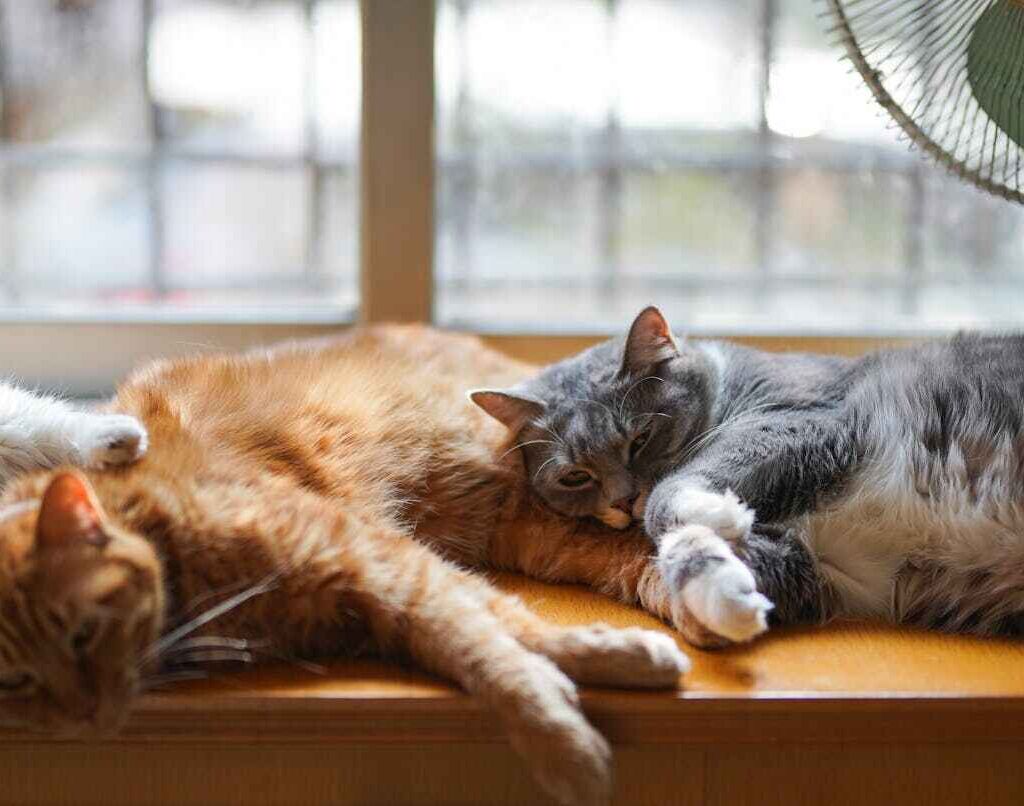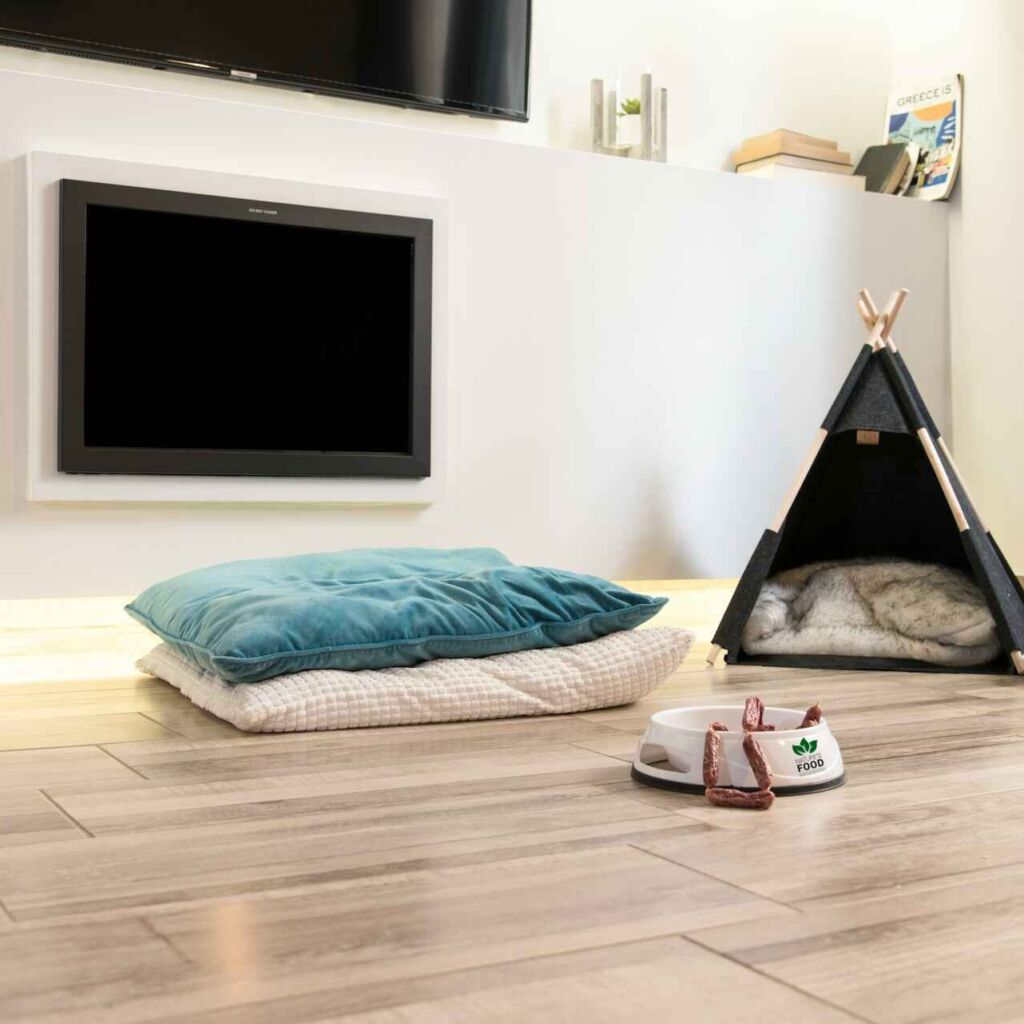Living with many cats can be challenging but rewarding with the right approach. It’s key to understand how cats behave to keep peace in your home. This guide offers top tips on managing cat behavior, from solving territorial issues to improving their well-being.
Learn how to handle competition over food and water, stress, and the need for personal space. These strategies will help you create a peaceful home for all your cats.

Key Takeaways
- Ensure each cat has at least one litter box, with an additional box to prevent accidents and conflicts.
- Provide separate feeding and water stations for each cat to minimize disputes over resources.
- Create private retreat areas to offer each cat personal space and reduce stress.
- Offer ample scratching surfaces of both vertical and horizontal varieties to cater to different preferences.
- Boost vertical space with perches near windows, cat trees, or shelves for observational advantage.
- Engage in regular interactive play sessions to maintain healthy weight and strengthen bonds.
- Utilize Feliway products to reduce stress and ease tensions among cats.
Understanding Cat Behavior and Territoriality
It’s key to understand cat aggression and feline territorial behavior to keep peace in homes with more than one cat. Cats are naturally protective of their space, leading to fights when their territory is threatened. Knowing why cats fight helps in solving these conflicts.
Why Cats Fight
Cat aggression often comes from fights over territory. This is especially true in homes with many cats, especially adult males who haven’t been neutered. They might hiss, swat, chase, or even attack due to territorial instincts.
There are many reasons why cats act this way:
- Sexual maturation
- Stress
- Change in routine
- Moving to a new house
- Introducing a new pet
- Lack of socialization during kittenhood
Common Causes of Territorial Disputes
Territorial aggression in cats takes many forms. Here are some common situations:
- Introduction of a New Cat: Adding a new cat can lead to fights as cats defend their territory.
- Sexual Challenges: Unneutered male cats may fight over females or to be the top cat.
- Defense Mechanism: Cats may become aggressive when they feel trapped or threatened.
- Redirected Aggression: Cats might attack another animal or person due to loud noises or fights with other cats.
It’s important to know the signs of territorial behavior in cats. Dominant cats may act aggressive or confront others. Less dominant cats might crouch, hide their heads, and show they’re upset by pulling back their ears. Some cats even get aggressive towards people, showing signs like stalking, swatting, or hissing.
Here’s a quick look at different types of cat aggression and what causes them:
| Type of Aggression | Triggers | Common Behaviors |
|---|---|---|
| Territorial Aggression | New cats, changes in environment | Hissing, swatting, chasing, attacking |
| Sexual Aggression | Establishing dominance, attracting mates | Fighting, vocalizing, marked posture |
| Defensive Aggression | Feeling cornered or threatened | Posturing, swatting, retreating |
| Redirected Aggression | External stimuli, stressors | Random attacks, unexpected aggression |
To manage cat aggression, it’s important to understand their territorial behavior and what triggers fights. By providing enough resources, respecting their space, and building positive relationships, you can make a peaceful home for all cats.
Providing Ample Resources
For peace and harmony in a home with many cats, it’s key to manage resources well. By meeting their needs, owners can cut down on fights and keep their pets happy.
Separate Feeding and Water Stations
One of the best ways to feed multiple cats is by giving them separate spots for food and water. This stops fights and lets each cat eat without stress. Experts say having individual bowls in different spots helps keep feeding times calm and tidy.
Sufficient Litter Boxes
For homes with many cats, it’s smart to follow the “number of cats + 1” rule for litter boxes. So, with three cats, you should have four litter boxes. This way, you avoid fights and make sure each cat has a clean spot, keeping the home clean and comfy.
Scratching Surfaces
Cats need to scratch, or they might damage your furniture. Providing lots of scratching posts and surfaces helps them do this in a good way. This stops them from scratching your furniture and keeps the home peaceful.
Using these strategies can really help lower stress and fights, making life better for cats and their owners.
Creating Private Retreats
In homes with many cats, it’s key to give each one its own space. This is crucial for a peaceful life for your cats. We’ll look into why personal space matters and how to make safe spots for your cats.
Importance of Personal Space
For homes with more than one cat, giving each a place to hide is vital. About 62% of U.S. homes have two or more cats. This often leads to stress and fights between cats, especially if they don’t have their own space.
Creating special spots for each cat can help solve dominance issues. These issues are found in 60% of homes with multiple cats. A quiet spot for a cat to hide can make your home calmer and less stressful for them.
How to Create a Safe Haven
Creating safe spots for cats is easy with the right items and places. Here are some tips:
- Designate Welcoming Spaces: Use carriers, open boxes, or quiet corners as hiding spots. They should be quiet and comfy.
- Utilize Calming Products: Items like Comfort Zone® Calming Diffusers can lessen a cat’s stress.
- Provide Multiple Options: Having more than one litter box helps, just like having more hiding spots does.
- Dedicated Play and Cuddle Sessions: Spend time playing and cuddling with each cat. This helps prevent jealousy and strengthens your bond.
The table below shows key actions to reduce stress and improve behavior in homes with many cats:
| Practice | Success Rate |
|---|---|
| Using multiple litter boxes | 85% |
| Positive reinforcement training | 75% |
| Using calming products like Feliway™ | 40% |
| Utilizing snug retreats | 70% |
Utilizing Vertical Space

Maximizing your cat’s environment with vertical space is key, especially in homes with more than one cat. Vertical areas let cats find safe spots to watch their territory and hide from stressors like kids or dogs.
Benefits of Vertical Territory
Vertical space has many benefits for cats. It gives them more territory, which is important in small homes or with many cats. Cats feel safer when they can be high up, avoiding fights and stress.
Vertical territory also keeps cats active. They can climb and explore, showing off their natural zoomies on high shelves. These spots near windows offer great views, sunlight, and fresh air, making their lives better.
Types of Vertical Solutions
There are many ways to add cat perches and trees to your home. Here are some good options:
- Cat Trees: Tall furniture with shelves for climbing and napping.
- Shelves: Wall-mounted shelves let cats move up and down easily.
- Window Seats: These are affordable and let multiple cats enjoy a window view.
- Vertical Scratching Posts with Shelves: These combine scratching and climbing.
When adding vertical space, make sure there are many ways for cats to climb up and down. This stops them from getting stuck in corners. The need for vertical space depends on the cat’s activity level and the size of their home. More active cats in smaller homes need more options.
Adding these vertical spaces makes sure your cats have fun, safe, and interactive places. This greatly improves their life quality.
Increase Exercise and Playtime
Keeping your cat happy and healthy means making sure they get enough exercise and fun activities. In homes with more than one cat, it’s key to focus on play to keep energy levels down and prevent bad behavior. Playing with your cat can make their life richer and keep your home peaceful.
Interactive Play Sessions
Interactive play is key for keeping cats sharp in mind and body. Try for two to three play sessions a day, each about 15 minutes long. Use different toys to keep your cat interested. Toys like cat teaser toys, laser pointers, and fishing rod toys are great for tapping into their natural hunting instincts.
Purr-fact interactive play sessions can help build a stronger bond between you and your feline friend.
Toys and Enrichment Activities
Offering a variety of toys and engaging in fun activities can really make your cat’s life better. Try using mixed toys like snapback stretchy toys and DIY toys like ping pong balls or paper towel rolls to keep things exciting.
- String-on-a-stick cat teaser toy
- Laser pointers or light toys
- Fishing rod toy
- Snapback stretchy toy
Get creative with DIY toys using things like corks, pipe cleaners, and cardboard boxes. Activities like hide & seek, tag, and fetch not only give your cat exercise but also strengthen your bond.
| Toy Type | Description |
|---|---|
| String-on-a-stick cat teaser toy | Great for chasing and pouncing |
| Laser pointer | Encourages quick reflexes and agility |
| Fishing rod toy | Engages hunting instincts |
| Snapback stretchy toy | Use for fetch and tug-of-war |
For more fun, try puzzle feeders, cat apps on tablets, blowing bubbles, or making a cardboard playground. These activities not only help your cat stay active but also keep them happy during their awake hours.
Addressing Medical Issues
Keeping a multi-cat household peaceful means paying attention to health issues. Cats may act differently if they’re not feeling well. Valarie V. Tynes, DVM, says changes in behavior often mean a cat is sick or upset.
Health problems like urinary tract infections or kidney disease can make cats avoid their litter box. To prevent fights, have one litter box for each cat, plus one more. Samantha Bell suggests not putting litter boxes in corners to avoid making cats feel trapped.
Cats can get sick and act out because of it. Look out for signs like a lot of scratching, losing hair, or vomiting. These could mean they have fleas, food allergies, or other health issues. Knowing about these illnesses helps you take care of your cats fast.
It’s important to take your cats to the vet regularly in a multi-cat home. This helps catch health problems early. Taking care of their health can make your home peaceful for everyone.
| Health Issues | Behavioral Indicators | Recommended Actions |
|---|---|---|
| Urinary Tract Infections | Avoiding Litter Box | Consult Vet, Provide Extra Litter Boxes |
| Kidney Disease | Increased Thirst, Litter Box Avoidance | Regular Vet Check-ups |
| Thyroid Disease | Weight Loss, Hyperactivity | Medication, Regular Monitoring |
| Diabetes | Increased Urination, Weight Loss | Insulin Treatment, Diet Management |
| Parasites (Fleas) | Excessive Scratching, Hair Loss | Flea Control Products, Vet Consultation |
Good vet care and watching over each cat’s health can stop behavior problems. Knowing what each cat needs and understanding their health issues keeps your home peaceful and healthy for all.
Using Feliway to Reduce Stress

Feliway for cats has changed the game in pheromone therapy. It’s the #1 choice for vets to help reduce stress and fights in homes with more than one cat. It mimics the calming pheromones cats naturally produce, making homes more peaceful.
With over 25 years of experience, Feliway offers products like Feliway MultiCat and Feliway Optimum. These products help lower tension and fights between cats. Cat owners praise how Feliway has made living with multiple cats better. Often, owners see improvements in just seven days, and a month of use is best for full results.
Studies funded by Ceva Animal Health show how Feliway helps with stress behaviors like spraying, hiding, scratching, overgrooming, and fighting. A 2001 study found it cut down on urine spraying in male cats. A 2015 study showed cats were calmer during vet visits with Feliway. Even with few studies, vets and happy cat owners recommend it.
Feliway’s prices vary, from $34.99 to $30.00, making it affordable for many. With over 1 million Facebook likes, its community keeps growing. This shows how effective it is in reducing stress in homes with more than one cat.
| Product | Price | Effectiveness | Recommendation |
|---|---|---|---|
| Feliway Optimum | $34.99 | Most advanced solution for stress reduction | High |
| Feliway MultiCat | $29.99 | Reduces signs of tension and conflict between cats | High |
| Feliway Classic Spray | $24.99 | Cats appeared less stressed during vet visits | Moderate |
| Feliway Friends | $30.00 | Reduces friction between cats | Moderate |
If you’re facing aggression, hiding, or want a calmer home, Feliway for cats is a great option. By using these products regularly, cat owners can greatly reduce stress. This leads to a more peaceful life for their cats.
Conclusion
Living with multiple cats can be challenging, but it can also be rewarding. By understanding their behavior and giving them what they need, like separate food spots and enough litter boxes, you can reduce fights. Also, giving each cat its own space and using vertical areas can help lower stress.
Adding regular play and exercise, taking care of health issues quickly, and using products like Feliway can make life better for your cats. Cats that live together can feel less lonely and happier. But remember, it means more money and space for your home.
To make a peaceful home for many cats, you need patience and careful planning. Stick to this guide to make sure you and your cats live happily and stress-free together.










